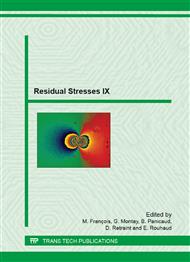[1]
E.I. Erlich and W.D. Hausel, Diamond Deposits, Society for Mining, Metallurgy and Exploration, Inc. USA, 2002 ISBN 0-87335-213-0.
Google Scholar
[2]
Y.A. Litvin, Russian Geology and Geophysics 50 (2009)1188-1200.
Google Scholar
[3]
K. Shibata and H. Kamioka Mineralogical Magazine 57 (1993) 607-611.
Google Scholar
[4]
G. Kletetschka, P.T. Taylor and P.J. Wasilewski, H.G.M. Hill, Earth and Planetary Science Letters 181 (2000) 279-290.
DOI: 10.1016/s0012-821x(00)00213-2
Google Scholar
[5]
M. Ozima, S. Zashu, K. Tomura and Y. Matsuhisa, Nature 351 (1991) 472-474.
DOI: 10.1038/351472a0
Google Scholar
[6]
J.D. Kramers, M.A.G. Andreoli, M. Atanasova, G.A. Belyanin, D.L. Block, C.B. Franklyn,C. Harris, M. Lekgoathi, C.S. Montross T.P. Ntsoane, V. Pischedda, P. Segonyane, K.S. Viljoen and J.E. Westraadt, Earth and Planetary Science Letters 382 (2013).
DOI: 10.1016/j.epsl.2013.09.003
Google Scholar
[7]
R. Z. Khaliullin, H. Eshet, T. D. Kühne, J. Behler and M. Parrinello, Nature Materials 10 (2011) 693-697.
DOI: 10.1038/nmat3078
Google Scholar
[8]
C. Frondel and U.B. Marvin, Nature 214 (5088) (1967) 587-589. Bibcode: 1967Natur. 214. 587F. doi: 10. 1038/214587a0.
DOI: 10.1038/214587a0
Google Scholar
[9]
P. Withers in: M.E. Fitzpatric, A. Lodini (Eds. ), Analysis of Residual Stress by Diffraction Using Neutron and Synchrotron Radiation, Taylor and Francis, London, 2003, p.170.
DOI: 10.1201/9780203608999.ch10
Google Scholar
[10]
O. Kirstein, U. Garbe and V. Luzin, Mater. Sci. Forum 652 (2010) 86.
Google Scholar
[11]
A. Steuwer, J. R. Santisteban, M. Turski, P. J. Withers and T. Buslaps, J. Appl. Cryst. 37 (2004) 883-889.
DOI: 10.1107/s0021889804023349
Google Scholar
[12]
V.A. Petrovsky, A.A. Shiryaev, V.P. Lyutoev, A.E. Sukharev and M. Martins, Eur. J. Mineral. 22 (2010) 35-47.
Google Scholar
[13]
D. Howell, S. Piazolo, D.P. Dobson, I.G. Wood, A.P. Jones, N. Walte, D.J. Frost, D. Fisher, and W.L. Griffin, Diamond Relat. Mater. 30 (2012) 20-30.
DOI: 10.1016/j.diamond.2012.09.003
Google Scholar
[14]
S. Han and J. Ihm, Physical Review Letters 80(5) (1998) 995-998.
Google Scholar
[15]
H. Kagi and S. Fakura, Eur. J. Mineral. 20 (2008) 387-393.
Google Scholar


